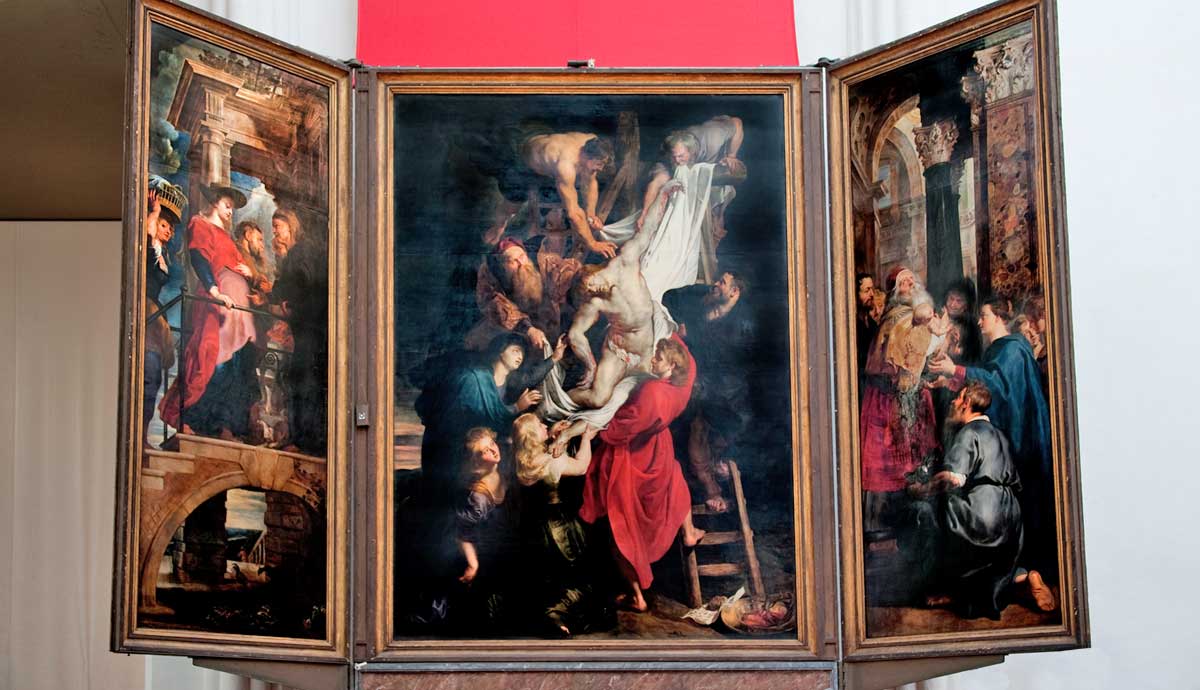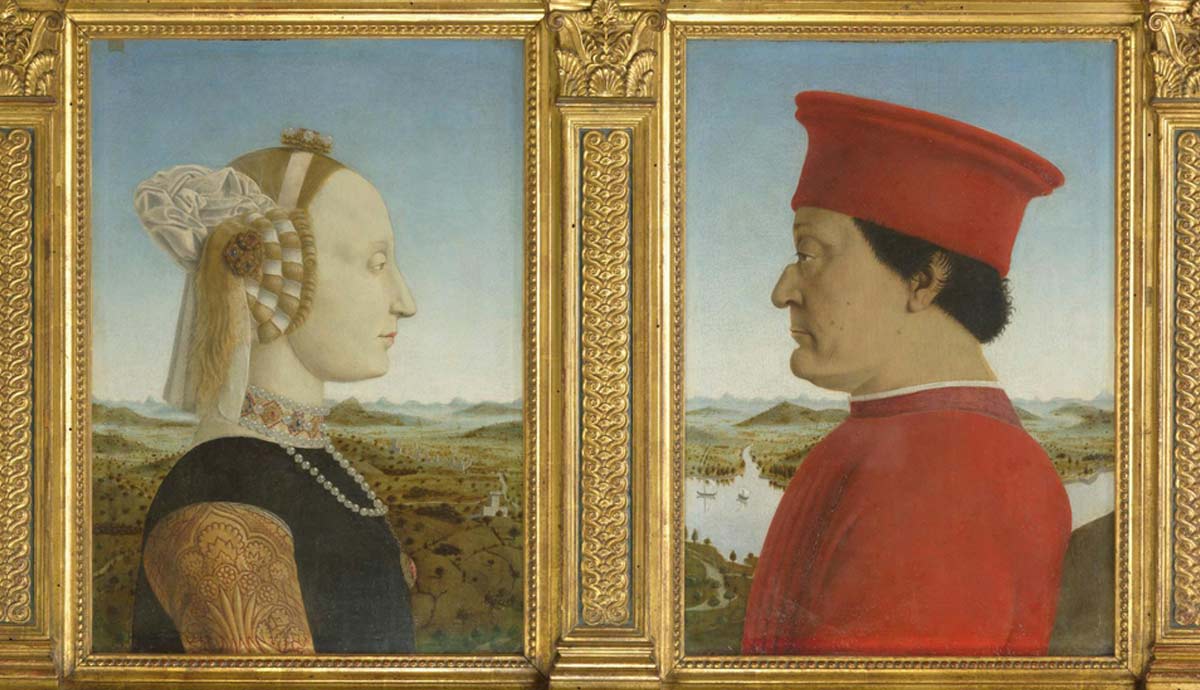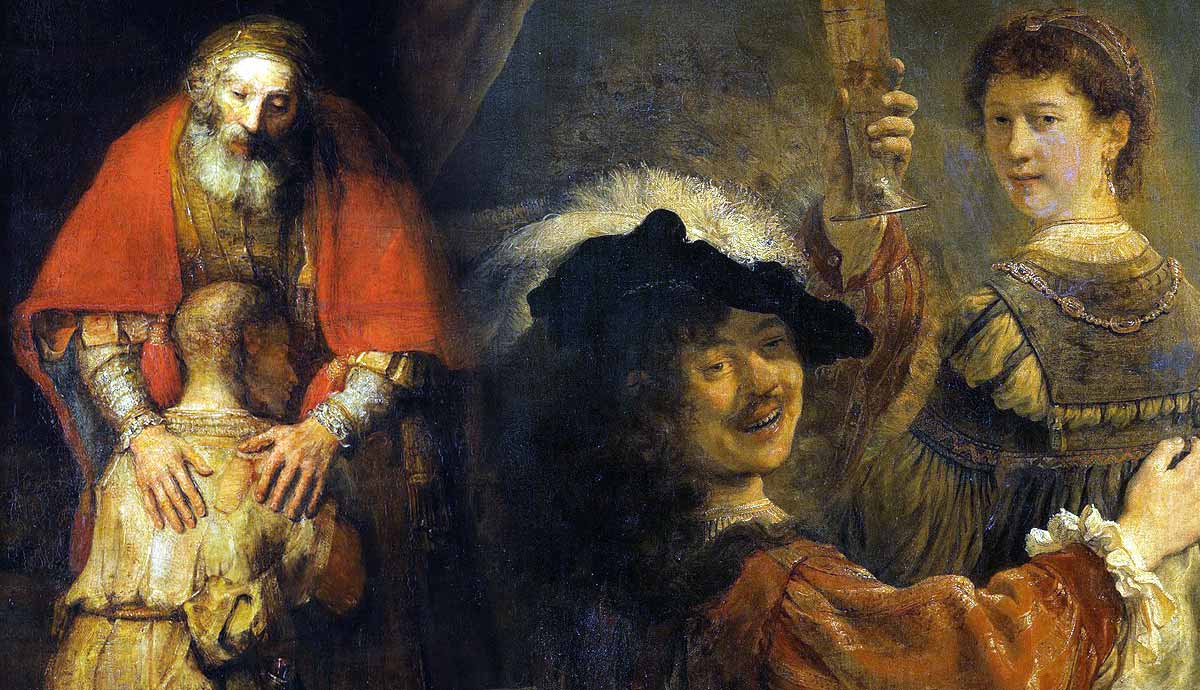
During the Medieval and Renaissance periods, patrons commissioned chapels as a conspicuous yet pious method of displaying their wealth and social status. One example is Enrico Scrovegni’s Arena Chapel in Padua, painted by Giotto. However, others preferred the religious altarpiece, either painted or sculpted. Altarpieces such as the Portinari and the Frari triptychs reflected well on the bankers and businessmen who commissioned them. In later centuries, though, the art of triptych evolved. What was a grand gesture in Renaissance society provided an alternative avenue of expression for contemporary artists.
By (Almost) Royal Appointment – The Donne Triptych

One of the finest examples of a Renaissance triptych was commissioned by Sir John Donne, the courtier and diplomat to the court of Edward IV. Donne was born in Picardy to a family rich in military and courtly pedigree. His father is said to have fought at the Battle of Agincourt. Donne rose through the ranks, serving the Duke of York, before becoming an eminent diplomat. His wife was similarly involved in court life as a lady-in-waiting to the queen.
Donne mixed with those of high standing at court, some of whom favored Netherlandish art. This may be how Donne became aware of Hans Memling and his prolific workshop. The format of the Donne Triptych was a common composition—centrally placed were the Virgin and Child surrounded by various saints, often those relevant to the donor’s life. In Donne’s case, Saint John the Baptist (considered the antecedent to Christ) appears in the left-hand wing, carrying his emblem, the sacrificial lamb. Saint John the Evangelist takes his place on the right wing, with Donne’s coat-of-arms in the window behind him.

In the central panel are the Virgin and Child, upon a throne with a cloth of honor above them and a luxurious Anatolian carpet at their feet. At their sides are angels with Saints Catherine and Barbara. Saint Catherine, the protector of the dying, is depicted with a sword bearing an image of a wheel. Saint Barbara holds her emblem, the tower where she converted to Christianity. She represents those in danger of sudden death. Saint Barbara presents Lady Donne to the Virgin and Child. Behind Lady Donne kneels a small girl, Donne’s daughter. Sir John Donne kneels at the Virgin’s right hand. He and his wife wear collars decorated with white roses and a pendant white lion, representing the livery of Edward IV, showing their wearers’ dedication to the Yorkist cause during the Wars of the Roses.
Rich in religious and royal symbolism, the triptych was more than an artwork. It is widely believed to have been commissioned for private devotion. Donne’s parents had obtained papal permission to own a portable altar—perhaps this assent was also bestowed on their son. Throughout his diplomatic career, Donne kept houses in Calais (at the time an English outpost on continental Europe) and Buckinghamshire and traveled widely. Perhaps the altarpiece was conveyed from residence to residence for Donne’s private prayers. As a work of art, it would have been impressive to his contemporaries as a real status symbol. It was a private altarpiece, for Donne and his family to pray for the protection of God, a comfort during the raging civil wars.
The Weird and Wonderful World of Hieronymus Bosch

In the years following Memling’s Donne Triptych and its formulaic composition, Netherlandish Renaissance art competed with its Italian counterpart. Although their general styles differed, the Netherlandish version was restrained, the Italian more gregarious and monumental, the general direction of subject matter and usage remained broadly similar. Until Hieronymus Bosch emerged.
Bosch was unlike any other artist working at the time. Little is known about his life, although we know that he was born into a family of painters. He lived all his life in and around the small town of s’Hertogenbosch, from which he took his working name. He was a successful artist in his lifetime and was commissioned by royalty and other high-ranking patrons. Most notably, Bosch was a master of the triptych, having painted at least sixteen of them, with eight still in existence today. Whilst other artists were painting altarpieces depicting the Holy Family and assorted saints surrounding an invariably rich and powerful donor, Bosch was creating a fantastical universe that turned conventional art on its head.
An Alchemist’s Dream: The Garden of Earthly Delights

Interpretations of The Garden of Earthly Delights are legion. They range from a straightforward biblical depiction of Adam and Eve’s experience of original sin and the consequences for humanity, to claims that it represents an alchemical view of the cycle of life. We know so little of the artist that his lifestyle and beliefs can give us no guidance. We are left to our own devices in unravelling the meaning of Bosch’s greatest work.
As a format, the triptych seems ideal for Bosch’s subject matter. In essence, he presents creation, the sins of life, then a descent into hell and judgment. Perhaps we have to first look at the closed triptych and Bosch’s grisaille image of the Earth during creation to understand the work. We see it just as God has separated the land from the seas, and the earthly paradise of Eden has been created. The grey tones depict the mists clearing as the garden emerges. If we open the doors to reveal the triptych’s interior, a riot of color and activity in sharp focus bombards our senses.

The left panel’s scene is serene. Christ stands beside Adam and Eve. Animals of all species graze peacefully. So far, so usual in biblical terms. But then we notice the elaborate pink fountain. Often seen as the Fountain of Life, it has also been likened to an alchemist’s vessel. Either interpretation could be right—only Bosch knew.
On entering the center panel, the feeling of ecstasy and hedonism is overwhelming. Bosch has created a world with no boundaries, neither of morals nor species. Bizarre creatures prowl. There is a half-bird with human legs, giant owls, and huge ears with a dagger protruding from them. To attach an accurate meaning to it is impossible. The profusion of fruit, especially strawberries and grapes, suggests a theme of fecundity. Seeds of fruit and flowers abound. The people feel no shame at their nudity and unbridled indulgence.

The final panel of the triptych plunges us into the depths of Hell. Despite being familiar with various Renaissance depictions of the subject, nothing quite prepares the viewer for Bosch’s version. Darkness reigns, a pig in nun’s garb forces itself upon a horrified man, enormous musical instruments blast unbearable noise into the ears of the damned. Everywhere the eye falls, another atrocity is revealed. This third of the triptych makes no bones about what awaits sinners following their descent into hell.

Memling’s Donne Triptych was intended as an object of private worship, made to be portable, suiting Donne’s transient lifestyle. Bosch’s huge example was quite the opposite. At approximately 6.5 feet by nearly 10 feet, it is not readily movable. So, who commissioned The Garden of Earthly Delights? What was its purpose? Maybe it was a conversation piece, designed to spark lively debate. It was located, shortly after Bosch’s death, in 1517, at the House of Nassau in Brussels, an important meeting place, receiving high-profile visitors from around Europe. Perhaps the patron wanted to impress them. Such an enormous and extraordinary artwork would certainly do that. How and why this giant of the Northern Renaissance came into being we may never know but Bosch’s use of the triptych form was certainly inspirational.
From the Profane to the Sacred – The Rothko Chapel

If Bosch’s Garden of Earthly Delights was a riot of human activity following the traditional format and subject matter of the Donne Triptych, Mark Rothko’s three triptychs in the Rothko Chapel in Houston, Texas, take the viewer to the other end of the spectrum. Rothko was greatly involved in the chapel design, funded by oil millionaires John and Dominique de Menil. His three triptychs and five other panel paintings were intended to envelop the viewer and provide a place for meditation and reflection. The chapel is octagonal to reflect traditional baptisteries. Originally a Roman Catholic chapel, it was later declared non-denominational. Rothko did not live to see the chapel’s inauguration in 1971, having died by suicide in New York in 1970.

Rothko’s three triptychs envelop the viewer. The format, familiar to us as a religious object of devotion, here forces the psyche into deep contemplation. The panels, a deep brown, are not a lesson in the wrongs of sin as Bosch depicted. They do not feature an image of their patron or creator, as with Memling and Donne. Rothko leaves interpretation and experience to the viewer. The next triptych we will look at is much more political.
AI Weiwei – The Triptych as Cultural Comment

Ai Weiwei’s artistic career has been long and varied. Persecution and imprisonment in his native China have never prevented him from producing controversial artwork. In 1995, he created further outrage in his native country with his triptych of photographs entitled Dropping a Han Dynasty Urn.
For this artwork, Ai Weiwei dropped a 2,000-year-old Han dynasty urn in what has been described as an act of cultural destruction. The Han dynasty was an important period in China’s history, known for its role in the country’s stabilisation and growth. To destroy an artifact from this era seems unthinkable. Beyond consideration of the object’s monetary value, such a culturally symbolic loss seems unjustifiable to the average person.

Ai Weiwei has countered adversity by reminding his critics of the words of Chairman Mao, following the decimation of ancient historical objects during the Cultural Revolution in the decade spanning 1966 to 1976. He said: “Chairman Mao used to tell us that we can only build a new world if we destroy the old one.” By destroying the urn, the artist forces the viewer to reconsider why we attach meaning to objects. He questions what makes something culturally important. In using the form of a triptych, Ai Weiwei creates a pause between each photograph, a decision emphasising the process of the urn falling to the ground. An act, taking seconds in reality, is forever paused. The urn’s form is rearranged, but has its cultural worth altered? Certainly, one might assume that its monetary value was lost, along with its form.
The Triptych Lives On

Over the centuries, the triptych has provided a chimeric form to artists. Memling’s formal donor triptych, commissioned by an eminent English diplomat, was a status symbol and a talisman, used in praying to God for safe passage through life and beyond. Bosch took the triptych to another place, a fantastical world of sin and punishment. From the depths of his imagination, he created a work, religious in its origins but with an element of voyeurism that boggles the mind.
In the 20th century, Mark Rothko transformed the triptych into an all-enveloping cocoon of elemental spiritual experience. In recent decades, Ai Weiwei has used the format to pause time and to force the viewer to think deeply about what makes an object culturally valuable. The triptych, in any form, seems set to stay. What will its next incarnation be?










